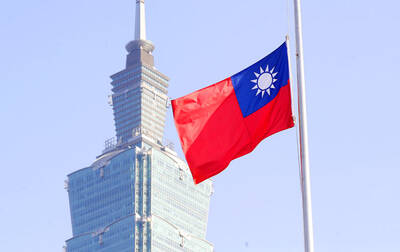Vietnam’s government yesterday said the country has sufficient rice stocks and threatened to punish speculators who hoard rice for profit after price surges triggered a run on the staple grain.
Many supermarkets and street stalls quickly ran out of rice in Ho Chi Minh City at the weekend as thousands of consumers, worried by rumors of looming shortages, queued to stock up on rice, further driving up retail prices.
Vietnamese Prime Minister Nguyen Tan Dung in an urgent message to all cities and provinces said that Vietnam, the world’s number-two rice exporter, has enough stocks to meet domestic and export demand amid record global rice prices.
The prime minister, whose government has been battling double-digit inflation driven by food and energy prices for months, warned traders of “severe punishment” if they hoard rice and speculate on the commodity for profit.
The government “strictly forbids organizations and individuals without function to trade food from buying paddy and rice for speculation,” said an official statement, following reports that investors had bought up rice stocks and refused to sell them while waiting for prices to climb even further.
The warnings came after sudden price increases from Saturday morning sent shoppers rushing to supermarkets, especially in the country’s largest city, amid what local media dubbed “rice fever.”
Shoppers and restaurant owners were piling large stacks of 10kg rice bags onto their motorcycles, while at least one supermarket chain, Saigon Co-op, limited sales to one bag per customer.
The Thanh Nien daily reported that, within several hours on Saturday, the price of 1kg of standard rice surged from 10,000 to 18,000 dong (US$0.63 to US$1.13) in many retail outlets, further fueling the run.
In other southern towns, including the Mekong delta hub of Can Tho, prices also went up fast, while some distributors stockpiling rice and turning away customers who then went to buy up noodles instead, media reports said.
Dung assured officials and citizens that “rice production of your country in 2008 can completely meet domestic consumption, and part of it can be exported.”
The government said last week it had stopped new rice export contracts until the end of June, despite a bumper harvest in the Mekong Delta, the main rice basket, to ensure food security and fight inflation.
Dung earlier capped this year’s national rice exports at 3.5 million tonnes, down from a previous target of 4.5 million tonnes, while Vietnam has honored export contracts, including shipments to rice-deficit country like the Philippines.
World grain prices have sky-rocketed, a trend blamed on higher energy and fertilizer costs, greater global demand, droughts, the loss of farmland to biofuel plantations, industry and cities, and on price speculation.
Vietnamese consumer prices have risen by more than 17 percent in the first four months of this year year-on-year, fueling popular anger and labor unrest.
Jonathan Pincus, the UN Development Program’s chief economist in Vietnam, said the country’s problem with rice was due to prices, not supplies.
“Vietnam is a food exporting country, where there is no problem of supplies,” Pincus said. “There are problems of prices, and higher prices hurt particularly people working for wages.”
“It’s very natural to see strikes and higher wage demands because people’s money is not going as far as it used to,” he said.
Pincus said he did not foresee food riots.
But Vietnam’s government knows “that some of the gains made in poverty reduction over the past 10 years are in jeopardy if they are not able to bring food prices into line,” he said.

When Lika Megreladze was a child, life in her native western Georgian region of Guria revolved around tea. Her mother worked for decades as a scientist at the Soviet Union’s Institute of Tea and Subtropical Crops in the village of Anaseuli, Georgia, perfecting cultivation methods for a Georgian tea industry that supplied the bulk of the vast communist state’s brews. “When I was a child, this was only my mum’s workplace. Only later I realized that it was something big,” she said. Now, the institute lies abandoned. Yellowed papers are strewn around its decaying corridors, and a statue of Soviet founder Vladimir Lenin

UNIFYING OPPOSITION: Numerous companies have registered complaints over the potential levies, bringing together rival automakers in voicing their reservations US President Donald Trump is readying plans for industry-specific tariffs to kick in alongside his country-by-country duties in two weeks, ramping up his push to reshape the US’ standing in the global trading system by penalizing purchases from abroad. Administration officials could release details of Trump’s planned 50 percent duty on copper in the days before they are set to take effect on Friday next week, a person familiar with the matter said. That is the same date Trump’s “reciprocal” levies on products from more than 100 nations are slated to begin. Trump on Tuesday said that he is likely to impose tariffs

HELPING HAND: Approving the sale of H20s could give China the edge it needs to capture market share and become the global standard, a US representative said The US President Donald Trump administration’s decision allowing Nvidia Corp to resume shipments of its H20 artificial intelligence (AI) chips to China risks bolstering Beijing’s military capabilities and expanding its capacity to compete with the US, the head of the US House Select Committee on Strategic Competition Between the United States and the Chinese Communist Party said. “The H20, which is a cost-effective and powerful AI inference chip, far surpasses China’s indigenous capability and would therefore provide a substantial increase to China’s AI development,” committee chairman John Moolenaar, a Michigan Republican, said on Friday in a letter to US Secretary of

ELECTRONICS BOOST: A predicted surge in exports would likely be driven by ICT products, exports of which have soared 84.7 percent from a year earlier, DBS said DBS Bank Ltd (星展銀行) yesterday raised its GDP growth forecast for Taiwan this year to 4 percent from 3 percent, citing robust demand for artificial intelligence (AI)-related exports and accelerated shipment activity, which are expected to offset potential headwinds from US tariffs. “Our GDP growth forecast for 2025 is revised up to 4 percent from 3 percent to reflect front-loaded exports and strong AI demand,” Singapore-based DBS senior economist Ma Tieying (馬鐵英) said in an online briefing. Taiwan’s second-quarter performance beat expectations, with GDP growth likely surpassing 5 percent, driven by a 34.1 percent year-on-year increase in exports, Ma said, citing government